
Palenque, also anciently known in the Itza Language as Lakamhaʼ, was a Maya city state in southern Mexico that perished in the 8th century. The Palenque ruins date from ca. 226 BC to ca. 799 AD. After its decline, it was overgrown by the jungle of cedar, mahogany, and sapodilla trees, but has since been excavated and restored. It is located near the Usumacinta River in the Mexican state of Chiapas, about 130 km south of Ciudad del Carmen, 150 meters (490 ft) above sea level. It averages a humid 26°C (79°F) with roughly 2,160 millimeters (85 in) of rain a year.
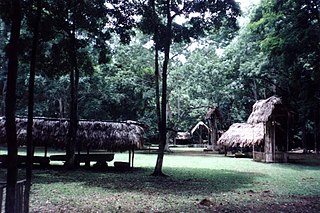
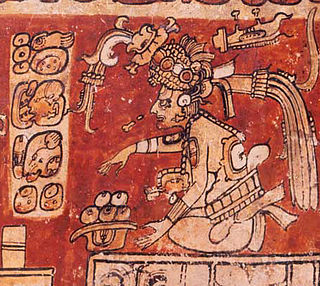
Itzamná is, in Maya mythology, an upper god and creator deity thought to reside in the sky. Itzamná is one of the most important gods in the Classic and Postclassic Maya pantheon. Although little is known about him, scattered references are present in early-colonial Spanish reports (relaciones) and dictionaries. Twentieth-century Lacandon lore includes tales about a creator god who may be a late successor to him. In the pre-Spanish period, Itzamná was often depicted in books and in ceramic scenes derived from them. Before the names of the Maya deities were deciphered, Itzamná was known as "god D", and is still sometimes referred to as "god D" by archeologists.

Yaxchilan is an ancient Maya city located on the bank of the Usumacinta River in the state of Chiapas, Mexico. In the Late Classic Period Yaxchilan was one of the most powerful Maya states along the course of the Usumacinta River, with Piedras Negras as its major rival. Architectural styles in subordinate sites in the Usumacinta region demonstrate clear differences that mark a clear boundary between the two kingdoms.

Linda Schele was an American Mesoamerican archaeologist who was an expert in the field of Maya epigraphy and iconography. She played an invaluable role in the decipherment of much of the Maya hieroglyphs. She produced a massive volume of drawings of stelae and inscriptions, which, following her wishes, are free for use to scholars. In 1978, she founded the annual Maya Meetings at The University of Texas at Austin.

K’uk’ulkan, also spelled Kukulkan, is the Mesoamerican serpent deity of the Pre-Columbine Yucatec Maya. It is closely related to the deity Qʼuqʼumatz of the Kʼicheʼ people and to Quetzalcoatl of Aztec mythology. Prominent temples to Kukulkan are found at archaeological sites in the Yucatán Peninsula, such as Chichen Itza, Uxmal and Mayapan.
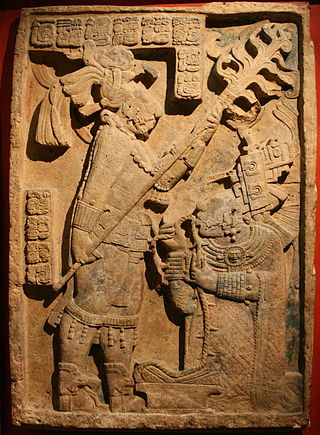
Lintel 24 is the designation given by modern archaeologists to an ancient Maya limestone sculpture from Yaxchilan, in modern Chiapas, Mexico. The lintel dates to about 723–726 AD, placing it within the Maya Late Classic period. Its mid-relief carving depicts the ruler of Yaxchilan, Itzamnaaj Bahlam III, and his consort Lady K’abal Xoc, performing a ceremony of bloodletting; the imagery is also accompanied by descriptive captions, and a signature by the sculptor, Mo’ Chaak.

Lady Kʼabʼal Xook[kʼaɓal ʃoːk] or Lady Xoc was a Maya Queen consort of Yaxchilan and is considered to have been one of the most powerful and prominent women in Maya civilization. She was the principal wife and aunt of King Itzamnaaj Bʼalam II, who ruled the prominent kingdom of Yaxchilan from 681 to 742. She is believed by many to have been the sister of Lady Pacal.
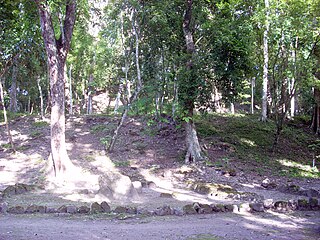
Ixlu is a small Maya archaeological site that dates to the Classic and Postclassic Periods. It is located on the isthmus between the Petén Itzá and Salpetén lakes, in the northern Petén Department of Guatemala. The site was an important port with access to Lake Petén Itzá via the Ixlu River. The site has been identified as Saklamakhal, also spelt Saclemacal, a capital of the Kowoj Maya.

Ucanal is an archaeological site of the ancient Maya civilization. It is located near the source of the Belize River in the Petén department of present-day northern Guatemala.

Maya monarchs, also known as Maya kings and queens, were the centers of power for the Maya civilization. Each Maya city-state was controlled by a dynasty of kings. The position of king was usually inherited by the oldest son.

Yaxun Bʼalam III (also known as 6-Tun-Bird-Jaguar) was a high king of the Mayan city Yaxchilan from 631 until 681.

Lady Eveningstar or Lady Ikʼ Skull (704-751), was a Maya queen and possible regent, wife of Itzamnaaj Bʼalam II, a Maya king of Yaxchilan. Their son, Yaxun Bʼalam IV - "Bird Jaguar", succeeded his father as king. She was possibly a regent for a period.

Yaxun Bʼahlam IV, also called Bird Jaguar IV, was a Mayan king from Yaxchilan. He ruled from 752 until 768 AD, continuing the period of prosperity started by his father Itzamnaaj Bʼahlam III. He had to struggle to take and hold power, as he was not perceived to be the rightful heir to the throne.

During the 7th and 8th centuries in Mesoamerica, there was an evident shift in the roles women played in ancient Maya society as compared with the previous two centuries. It was during this time that there was a great deal of political complexity seen both in Maya royal houses as well as in the Maya area. Warfare was a significant factor in political competition and marriage was one of the ways that alliances were made between the different polities. This was accompanied by a shift in women's roles from wife and mother to playing integral parts in courtly life, such as participating in rituals involving the supernatural world and at times ruling individual polities.
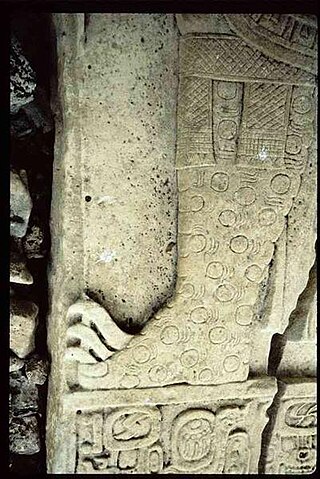
Uchaʼan Kʼin Bʼalam was the fourth Mayan king of Dos Pilas. He is also known as the Ruler 3, Master of Sun Jaguar, Scroll-head God K, Spangle-head and Jewelled-head. His title was "He of Five Captives".
Yoʼnal Ahk III, also known as Ruler 5, was an ajaw of Piedras Negras, an ancient Maya settlement in Guatemala. He ruled during the Late Classic Period, from 758 to 767 AD. Yoʼnal Ahk III ascended to the throne upon the death of Itzam Kʼan Ahk II, who may have been Yoʼnal Ahk's father. He was succeeded by his probable brother, Haʼ Kʼin Xook in around 767 AD. Yoʼnal Ahk III left behind two surviving stelae at Piedras Negras, namely Stelae 14 and 16, the former of which has been called one of the finest niche stelae, according to Simon Martin and Nikolai Grube.

Lady Pakal was a Maya Queen consort of Yaxchilan in Mexico.
Itzamnaaj Bʼalam II was a Mayan king who ruled in Yaxchilan. Experts usually date his reign between the end of the 6th century and the beginning of the 7th century, around 599 or even until around 610. Very little is known of him. He is also called Shield Jaguar by modern writers, based on the name glyph before the phonetic name was deciphered.













